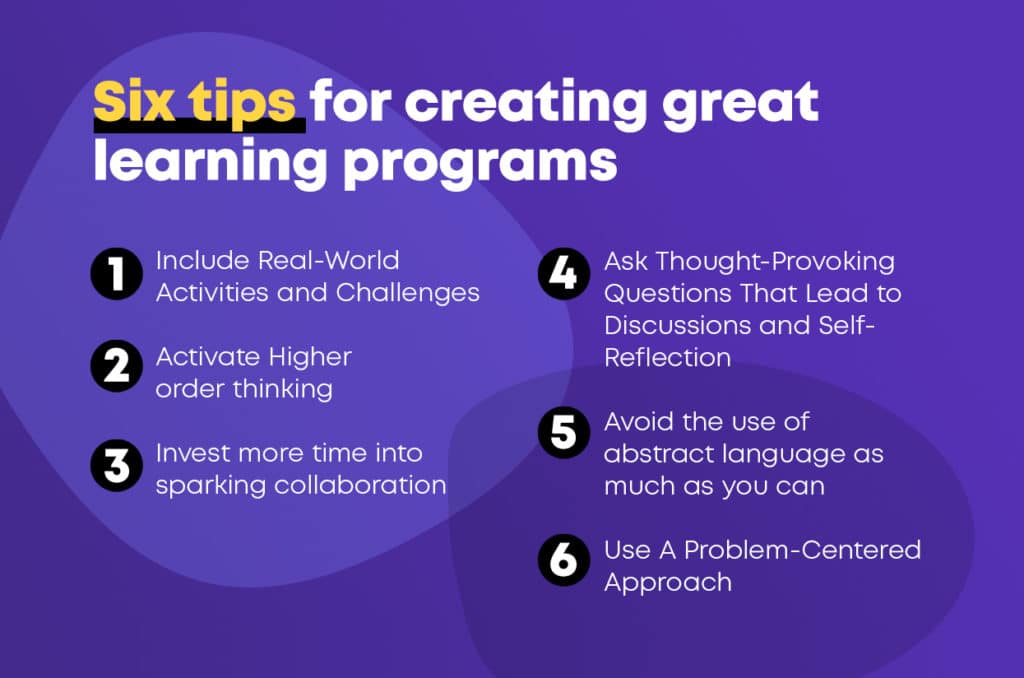The difference between a failed online learning program and a successful one can often depend on how much relevance and engagement you bring into the learning process. Because online learning can sometimes feel isolating and far removed from real-life, the opportunities to disengage and lose motivation are plentiful. As such, you should give your online learners plenty of opportunities to apply their knowledge as close to real-life as possible.
For example, if you need to learn how to use a piece of equipment or product that you will eventually need in front or alongside customers, practice during the learning process will give you the confidence needed to deliver when the customers come along.
The same is true for your learners when you allow them to practice, especially within their learning group, demo to one another and give and receive feedback. These activities allow learners to apply the knowledge they have gained in situations that are essentially free of the pressure and stress present in a real-life demo, allowing them to focus on what matters. In this particular activity, there is the bonus that learners can learn from each other through observation, strengthening the overall learning.
Your online learners, in any context, should get the opportunity to apply their knowledge in a realistic and relatable context. Offer up tasks and activities where they can use their newfound skills and knowledge to do things, add a good dose of self-guided instructions and collaboration tasks, and you have yourself a hyper-relevant and interactive online learning group. Not only that, but you have also significantly reduced the learning curve between getting the skills and applying the skills outside of the classroom.
Claned’s learning model centres on self-guided exploration, diverse content delivery, group discussions and peer interaction.
Too often do we hear stories, stats and studies about the shortcomings of online learning – e.g. the massive (around 90%) drop-out rate of MOOC’s, but it doesn’t and shouldn’t be this way. Often it’s not the content that’s the issue but the delivery method, lack of community, interaction and socialization that happens around learning.
By taking inspiration from world-renowned Finnish educational practices and leading research on how learning happens, Claned brings a more social, engaging and effective way to do online learning.
Here are six tips to use when designing your learning program in Claned.

1. Include real-world activities and challenges
Keep your learning tethered to realize situations and challenges – Do this by providing learning materials, activities and assignments that are modelled after real-world challenges, or both. For example, An entrepreneurship course may include information and activities about making business plans, grant writing, and market research, but merely telling people how to do these is often not enough for people to succeed in real-life. Putting the learners into groups with an assignment to actually do these things and behave as though the group is a startup is a great way to get them to practice and apply the learning and work in an authentic context – who knows, you might even help to launch a new venture!
When online learners apply what they are learning in a realistic context, they get to incorporate ideas, concepts and pre-existing knowledge from their daily lives and see the effects of adding new information when approaching these problems, instead of merely memorizing theories.
Incorporating real-world activities and assignments that mimic the types of obstacles and challenges they face or will face into an online learning course, they see the overall learning program as more relevant. It boosts their intrinsic motivation to engage.
For example, a team-building activity wherein online learners must resolve conflicts and communicate with their collaborators to hone their Project Management skills. These are all challenges that any team faces when solving a problem or developing a product. While technical know-how is undoubtedly a critical component in the process, so-called “soft-skills” such as collaboration, communication, and negotiation arguably play an equally important role, without which the real-world problems will not get solved. Having the opportunity to practice these alongside their core expertise is an invaluable learning opportunity and can make the difference between success and failure out in the world.
2. Activate Higher-order thinking
A core component of most modern models of learning is activating “higher-order thinking”. Higher-order-thinking refers to the cognitive and meta-cognitive thinking that goes on when we learn – that is, reflecting on what you know, what you don’t know and what you need to know to solve a problem or apply new knowledge. It also refers to how individuals synthesize new expertise into their mental model – this involves connecting past knowledge and experiences to the new knowledge gained. When this process happens, we can say that learning has occurred because afterwards, the way an individual approaches a task problem has changed. They bring a new perspective with fresh information as part of their mental tool-kit for completing tasks and solving problems.
Higher-order thinking is how your learners move from a receptive mode of information consumption into more active engagement modes such as reflection, analyzing and experimenting with new knowledge to solve practical problems.
Example: Jerremy wants to build a robot. He has an understanding of mechanics and circuitry from previous studies but doesn’t know how to code. After being shown some different coding languages and understanding their purpose and capabilities, he can incorporate that with his existing knowledge and select the most appropriate one to base his robots features and purpose. Now Jerremy is excited and focused – ready for the next steps
Learners should have the opportunity to form their assumptions based on data and pre-existing knowledge and assign meaning to the eLearning content they receive during their studies.
In the real world, information that we’ve stored in our memory can be used in various ways, not simply in contextual settings. As an example, You are in a new city or area, using the map for the first time to find a coffee shop, the following day, in the same spot you need to find a sandwich place, it would be just a little easier as you can call on learnings from the day before to find your way around.
Similarly, your online learning design should encourage learners to bring outside knowledge into their existing repertoire to help them complete assignments and assimilate the new knowledge into their internal models. A great way to accomplish this is by creating spaces within courses where learners can upload activities and tasks that ask them to put the knowledge and subject matter into their own words. Creating presentations, infographics, videos, or other learning materials are all excellent examples of such activities.
3. Invest more time into sparking collaboration
Online collaborative projects allow learners to explore different perspectives and benefit from the experience of their peers. At Claned, we put a big emphasis on social interaction and engagement during learning practices. While most learners are happy to participate and enjoy these activities in the online learning space, many need reminders to help bring them back into the learning experience and alert them to ongoing tasks. It is, therefore, crucial for you as an online course creator or an online course facilitator to plan these instructions and reminders into your design and workflow. Many course creators provide these in the information packet or page offered at the start of the online course, but that’s not sufficient. Go a step further, add instructions and reminders inside individual learning materials, and ask them to use the commenting and question tools to provide an excellent social engagement. Encourage peer-based feedback in your online collaboration group projects. Online learners can identify personal areas for improvement, so lean on those skills and expertise in the learning group bridge the learning gaps.
4. Ask thought-provoking questions that lead to discussions and self-refection
Sometimes, all that is needed is a carefully crafted question to ignite an online discussion and enhance your eLearning course’s relevancy. By encouraging learners to think independently and explore problems from multiple angles, they may discover the information they otherwise might not encounter. For example, asking a question that prompts them to research the subject matter and explore different perspectives requires learners to seek answers independently. They evaluate the information, combine it with their pre-existing knowledge and determine the best course of action based on what they have learned.
5. Avoid the use of abstract language as much as you can
Using real-world examples, stories, and case studies in your materials help learners draw connections between the often conceptual and theoretical nature of learning materials with their day-to-day experience. An example of a sales employee using their communication and active listening skills to address a customer’s concerns provides a better context than a speech on the more abstract sales strategies and cadences.

In the salesperson’s example, your learners might more easily imagine themselves apply the same techniques; perhaps it even brings to mind a situation they experienced where those skills would have been helpful. The point is to get learners to see how they would apply those same skills to improve their work performance. Even a learner who doesn’t deal with the particular topic (in this example, sales) can still assimilate the fundamentals and use them differently.
6. Use a problem-centered approach
At the heart of any learning are real-world problems, which learners must be able to solve. Challenges that we encounter in our daily lives become a focal point. Problem-based materials and exercises allow learners to seek answers and figure out how to solve a problem or overcome obstacles using all the resources and knowledge. Using problem-centred activities provides opportunities for learners to see themselves inside the subject matter. Learners are more likely to participate when the ideas or concepts presented are familiar.
An effective way of doing this is building your online course around a central pragmatic problem, fictional or otherwise; you can even ask your learners to send in sample problems ahead or at the start of the program.
Then layer your course materials around this problem as sorts of pieces in the puzzle. Ask the online collaboration groups to work on different parts and bring them together in the joint sessions. Offer the topical facts and stats as fundamental knowledge blocks to help them decide which pieces to fit together or open their mind to diverse solutions resulting from varying combination of parts.
Recognizing the need for and advantages of online learning is critical in today’s fast-paced world; perhaps of equal importance is understanding that online learning needs to take a different approach than traditional formats. It’s an exciting frontier because we get to play with ideas, new tools, and create solutions, but it’s certainly not without its challenges. At Claned, we see that as a big part of our jobs to help find the solutions and provide the answers and tools that will support learning make the leap to digital. By utilising the techniques outlined here, you can build learning experiences that are not only effective but fun and engaging – which, if you’ve been paying attention – are really 2 sides (3 sides?) of the same coin.
Ready to up your game with e-learning that actually works? Book a demo to find out how we can help!







